Analyzing Disney's Response to Tourism Challenges in Theme Parks
VerifiedAdded on 2023/04/21
|12
|2924
|89
Report
AI Summary
This report analyzes the challenges faced by The Walt Disney Company's theme parks in attracting international tourists, focusing on the organization's response to evolving consumer preferences and increased competition. It identifies a key challenge as the lack of proactive adaptation to changing consumer demands for thrilling experiences and modern facilities. The report examines Disney's attempts to address these challenges by leveraging nostalgia, heritage tourism, and creating "real America" experiences. A critical analysis assesses the effectiveness of Disney's strategies, highlighting both successes in maintaining heritage appeal and shortcomings in modernizing visitor experiences and competing with newer attractions. The report concludes by emphasizing the need for continuous adaptation to maintain competitiveness and relevance in the tourism industry, utilizing Desklib for further research and study aids.

Running head: INTERNATIONAL TOURISM MANAGEMENT
INTERNATIONAL TOURISM MANAGEMENT
Name of the Student
Name of the University
Author Note
INTERNATIONAL TOURISM MANAGEMENT
Name of the Student
Name of the University
Author Note
Paraphrase This Document
Need a fresh take? Get an instant paraphrase of this document with our AI Paraphraser
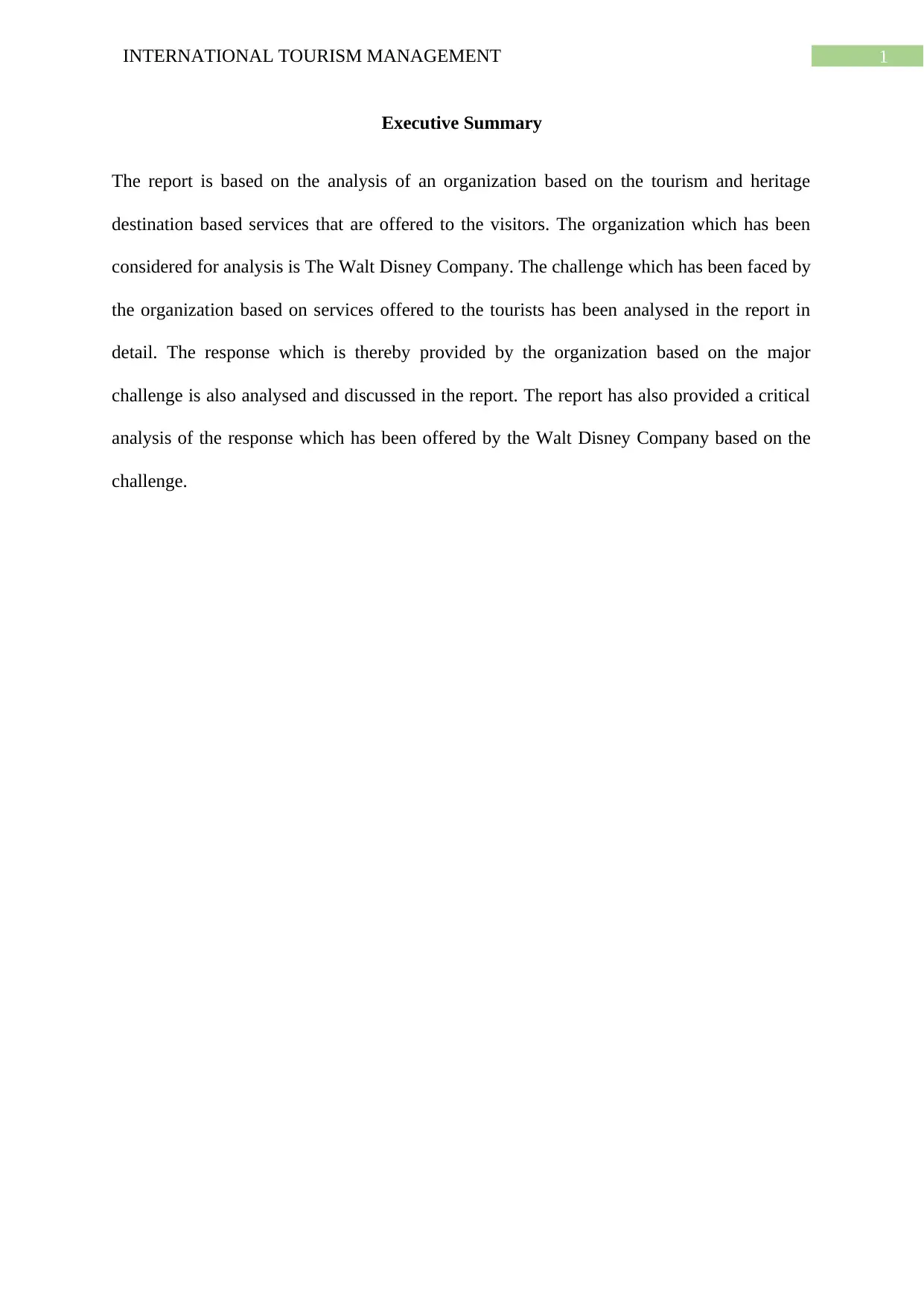
1INTERNATIONAL TOURISM MANAGEMENT
Executive Summary
The report is based on the analysis of an organization based on the tourism and heritage
destination based services that are offered to the visitors. The organization which has been
considered for analysis is The Walt Disney Company. The challenge which has been faced by
the organization based on services offered to the tourists has been analysed in the report in
detail. The response which is thereby provided by the organization based on the major
challenge is also analysed and discussed in the report. The report has also provided a critical
analysis of the response which has been offered by the Walt Disney Company based on the
challenge.
Executive Summary
The report is based on the analysis of an organization based on the tourism and heritage
destination based services that are offered to the visitors. The organization which has been
considered for analysis is The Walt Disney Company. The challenge which has been faced by
the organization based on services offered to the tourists has been analysed in the report in
detail. The response which is thereby provided by the organization based on the major
challenge is also analysed and discussed in the report. The report has also provided a critical
analysis of the response which has been offered by the Walt Disney Company based on the
challenge.
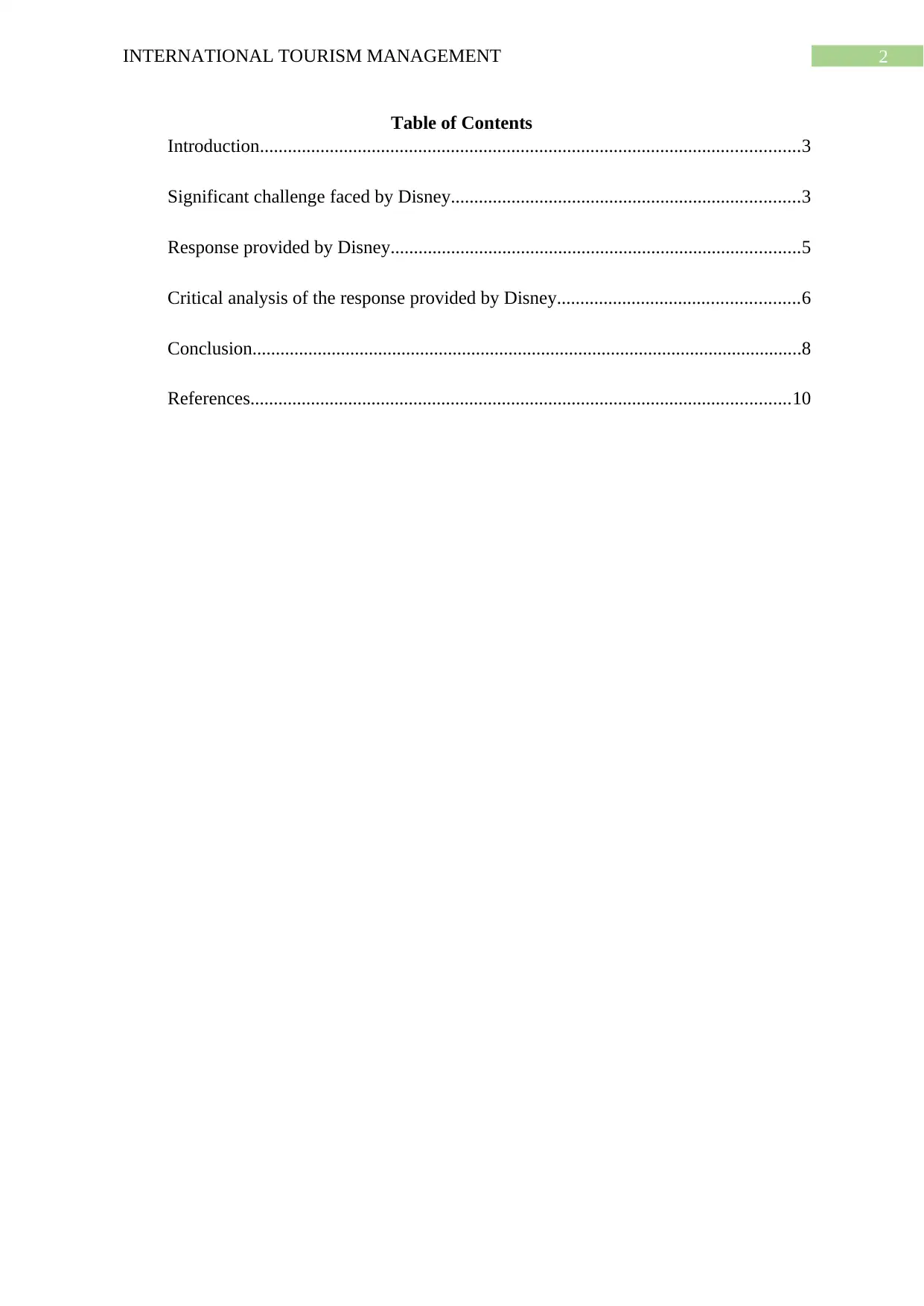
2INTERNATIONAL TOURISM MANAGEMENT
Table of Contents
Introduction....................................................................................................................3
Significant challenge faced by Disney...........................................................................3
Response provided by Disney........................................................................................5
Critical analysis of the response provided by Disney....................................................6
Conclusion......................................................................................................................8
References....................................................................................................................10
Table of Contents
Introduction....................................................................................................................3
Significant challenge faced by Disney...........................................................................3
Response provided by Disney........................................................................................5
Critical analysis of the response provided by Disney....................................................6
Conclusion......................................................................................................................8
References....................................................................................................................10
⊘ This is a preview!⊘
Do you want full access?
Subscribe today to unlock all pages.

Trusted by 1+ million students worldwide
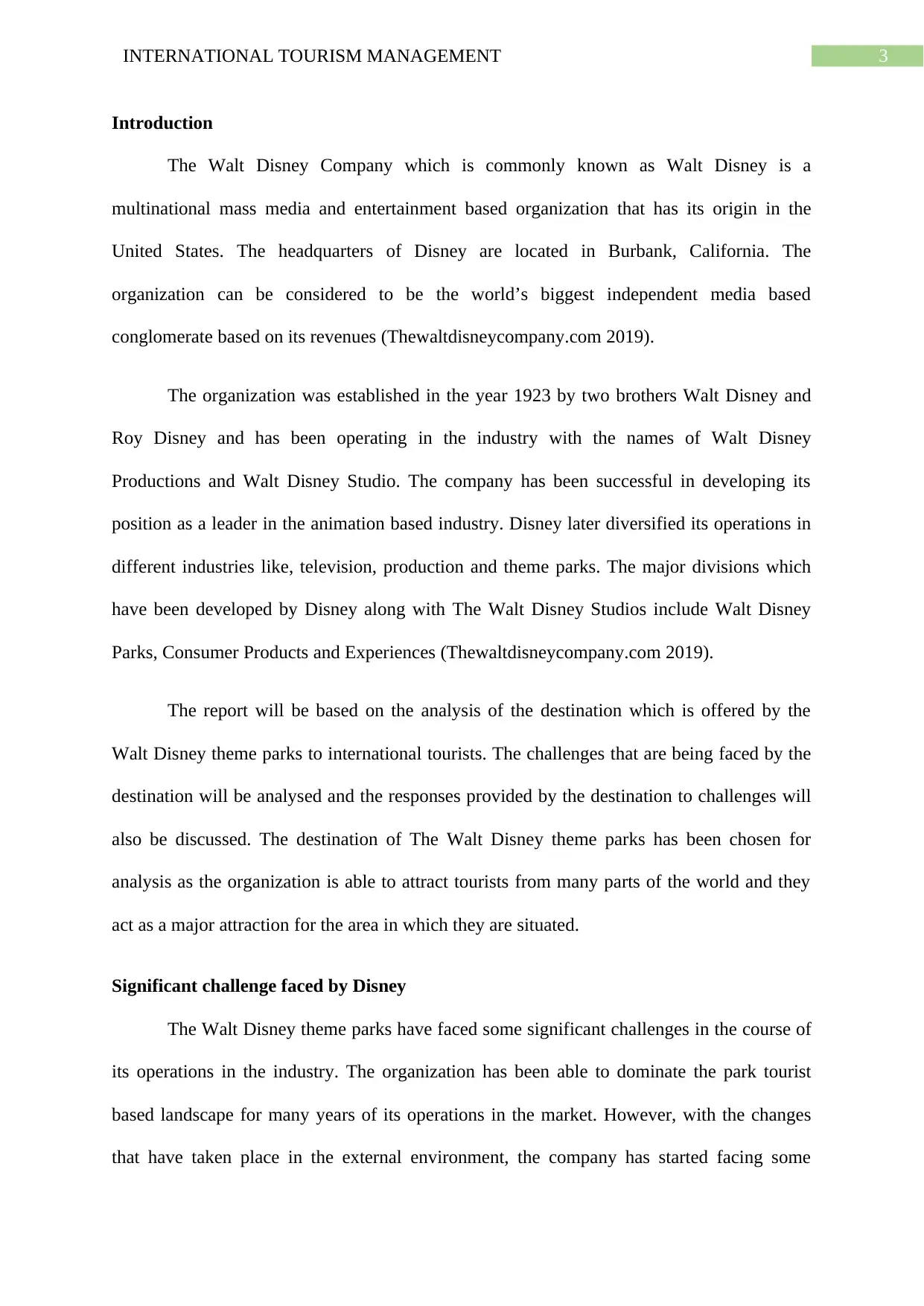
3INTERNATIONAL TOURISM MANAGEMENT
Introduction
The Walt Disney Company which is commonly known as Walt Disney is a
multinational mass media and entertainment based organization that has its origin in the
United States. The headquarters of Disney are located in Burbank, California. The
organization can be considered to be the world’s biggest independent media based
conglomerate based on its revenues (Thewaltdisneycompany.com 2019).
The organization was established in the year 1923 by two brothers Walt Disney and
Roy Disney and has been operating in the industry with the names of Walt Disney
Productions and Walt Disney Studio. The company has been successful in developing its
position as a leader in the animation based industry. Disney later diversified its operations in
different industries like, television, production and theme parks. The major divisions which
have been developed by Disney along with The Walt Disney Studios include Walt Disney
Parks, Consumer Products and Experiences (Thewaltdisneycompany.com 2019).
The report will be based on the analysis of the destination which is offered by the
Walt Disney theme parks to international tourists. The challenges that are being faced by the
destination will be analysed and the responses provided by the destination to challenges will
also be discussed. The destination of The Walt Disney theme parks has been chosen for
analysis as the organization is able to attract tourists from many parts of the world and they
act as a major attraction for the area in which they are situated.
Significant challenge faced by Disney
The Walt Disney theme parks have faced some significant challenges in the course of
its operations in the industry. The organization has been able to dominate the park tourist
based landscape for many years of its operations in the market. However, with the changes
that have taken place in the external environment, the company has started facing some
Introduction
The Walt Disney Company which is commonly known as Walt Disney is a
multinational mass media and entertainment based organization that has its origin in the
United States. The headquarters of Disney are located in Burbank, California. The
organization can be considered to be the world’s biggest independent media based
conglomerate based on its revenues (Thewaltdisneycompany.com 2019).
The organization was established in the year 1923 by two brothers Walt Disney and
Roy Disney and has been operating in the industry with the names of Walt Disney
Productions and Walt Disney Studio. The company has been successful in developing its
position as a leader in the animation based industry. Disney later diversified its operations in
different industries like, television, production and theme parks. The major divisions which
have been developed by Disney along with The Walt Disney Studios include Walt Disney
Parks, Consumer Products and Experiences (Thewaltdisneycompany.com 2019).
The report will be based on the analysis of the destination which is offered by the
Walt Disney theme parks to international tourists. The challenges that are being faced by the
destination will be analysed and the responses provided by the destination to challenges will
also be discussed. The destination of The Walt Disney theme parks has been chosen for
analysis as the organization is able to attract tourists from many parts of the world and they
act as a major attraction for the area in which they are situated.
Significant challenge faced by Disney
The Walt Disney theme parks have faced some significant challenges in the course of
its operations in the industry. The organization has been able to dominate the park tourist
based landscape for many years of its operations in the market. However, with the changes
that have taken place in the external environment, the company has started facing some
Paraphrase This Document
Need a fresh take? Get an instant paraphrase of this document with our AI Paraphraser
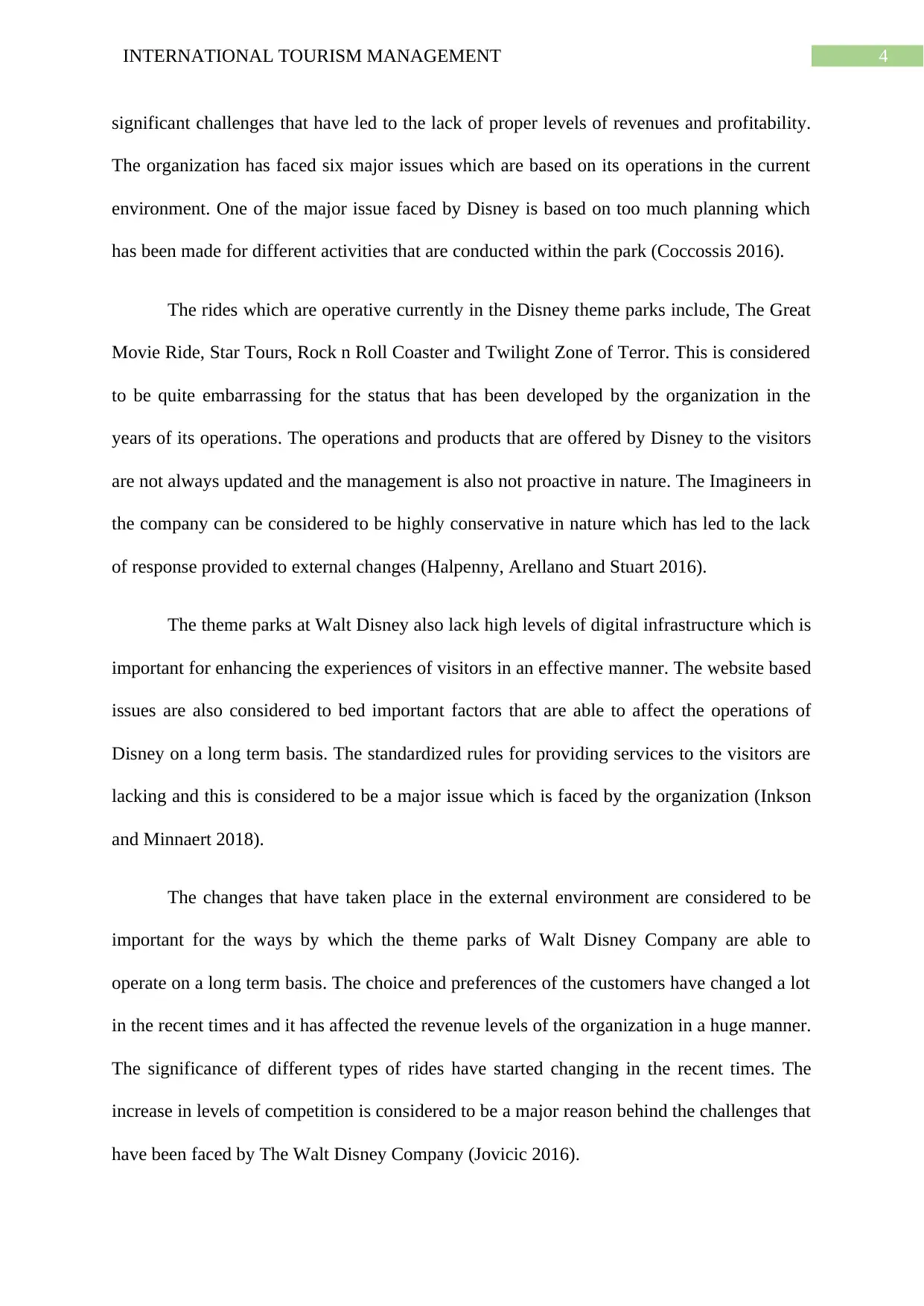
4INTERNATIONAL TOURISM MANAGEMENT
significant challenges that have led to the lack of proper levels of revenues and profitability.
The organization has faced six major issues which are based on its operations in the current
environment. One of the major issue faced by Disney is based on too much planning which
has been made for different activities that are conducted within the park (Coccossis 2016).
The rides which are operative currently in the Disney theme parks include, The Great
Movie Ride, Star Tours, Rock n Roll Coaster and Twilight Zone of Terror. This is considered
to be quite embarrassing for the status that has been developed by the organization in the
years of its operations. The operations and products that are offered by Disney to the visitors
are not always updated and the management is also not proactive in nature. The Imagineers in
the company can be considered to be highly conservative in nature which has led to the lack
of response provided to external changes (Halpenny, Arellano and Stuart 2016).
The theme parks at Walt Disney also lack high levels of digital infrastructure which is
important for enhancing the experiences of visitors in an effective manner. The website based
issues are also considered to bed important factors that are able to affect the operations of
Disney on a long term basis. The standardized rules for providing services to the visitors are
lacking and this is considered to be a major issue which is faced by the organization (Inkson
and Minnaert 2018).
The changes that have taken place in the external environment are considered to be
important for the ways by which the theme parks of Walt Disney Company are able to
operate on a long term basis. The choice and preferences of the customers have changed a lot
in the recent times and it has affected the revenue levels of the organization in a huge manner.
The significance of different types of rides have started changing in the recent times. The
increase in levels of competition is considered to be a major reason behind the challenges that
have been faced by The Walt Disney Company (Jovicic 2016).
significant challenges that have led to the lack of proper levels of revenues and profitability.
The organization has faced six major issues which are based on its operations in the current
environment. One of the major issue faced by Disney is based on too much planning which
has been made for different activities that are conducted within the park (Coccossis 2016).
The rides which are operative currently in the Disney theme parks include, The Great
Movie Ride, Star Tours, Rock n Roll Coaster and Twilight Zone of Terror. This is considered
to be quite embarrassing for the status that has been developed by the organization in the
years of its operations. The operations and products that are offered by Disney to the visitors
are not always updated and the management is also not proactive in nature. The Imagineers in
the company can be considered to be highly conservative in nature which has led to the lack
of response provided to external changes (Halpenny, Arellano and Stuart 2016).
The theme parks at Walt Disney also lack high levels of digital infrastructure which is
important for enhancing the experiences of visitors in an effective manner. The website based
issues are also considered to bed important factors that are able to affect the operations of
Disney on a long term basis. The standardized rules for providing services to the visitors are
lacking and this is considered to be a major issue which is faced by the organization (Inkson
and Minnaert 2018).
The changes that have taken place in the external environment are considered to be
important for the ways by which the theme parks of Walt Disney Company are able to
operate on a long term basis. The choice and preferences of the customers have changed a lot
in the recent times and it has affected the revenue levels of the organization in a huge manner.
The significance of different types of rides have started changing in the recent times. The
increase in levels of competition is considered to be a major reason behind the challenges that
have been faced by The Walt Disney Company (Jovicic 2016).
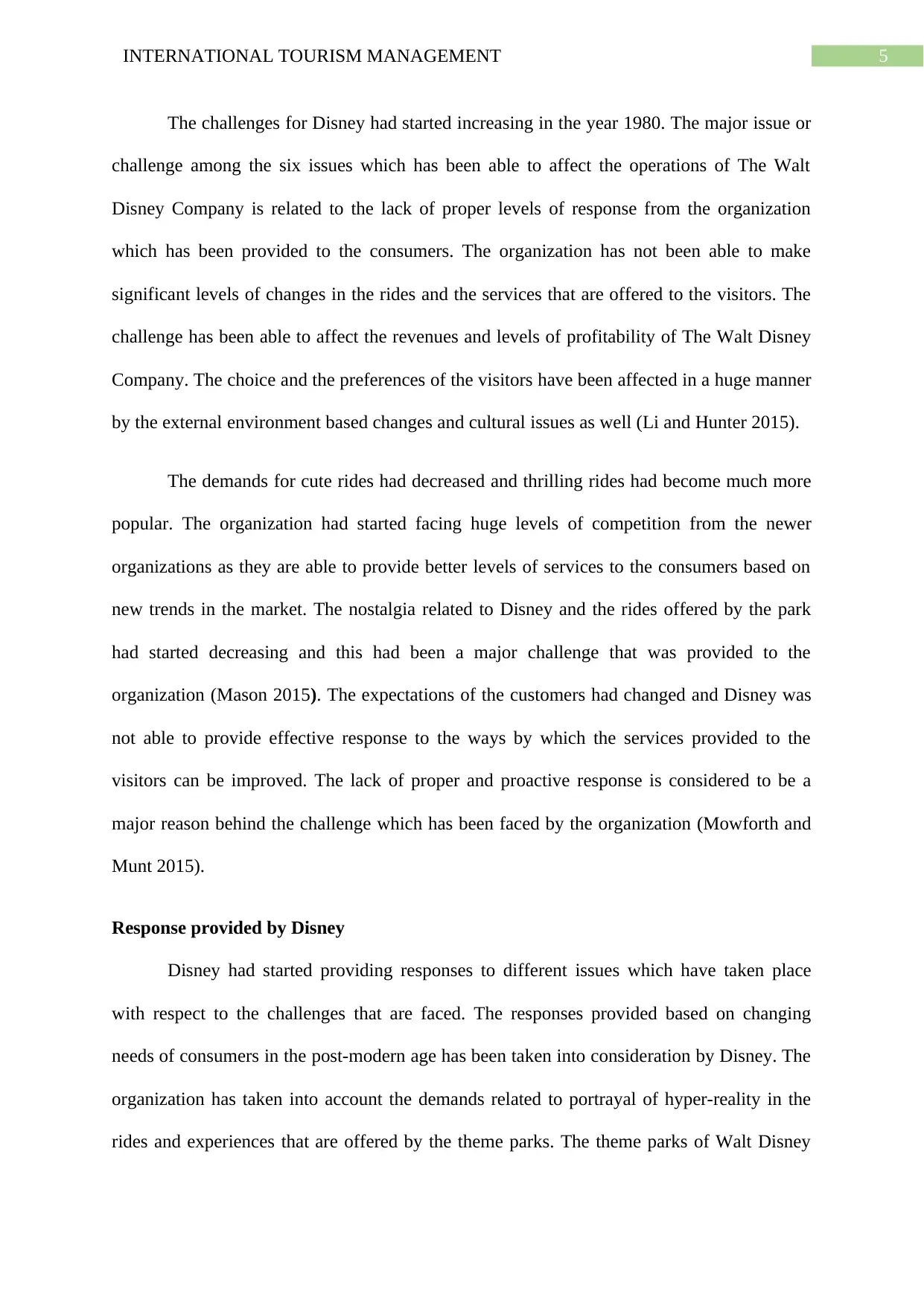
5INTERNATIONAL TOURISM MANAGEMENT
The challenges for Disney had started increasing in the year 1980. The major issue or
challenge among the six issues which has been able to affect the operations of The Walt
Disney Company is related to the lack of proper levels of response from the organization
which has been provided to the consumers. The organization has not been able to make
significant levels of changes in the rides and the services that are offered to the visitors. The
challenge has been able to affect the revenues and levels of profitability of The Walt Disney
Company. The choice and the preferences of the visitors have been affected in a huge manner
by the external environment based changes and cultural issues as well (Li and Hunter 2015).
The demands for cute rides had decreased and thrilling rides had become much more
popular. The organization had started facing huge levels of competition from the newer
organizations as they are able to provide better levels of services to the consumers based on
new trends in the market. The nostalgia related to Disney and the rides offered by the park
had started decreasing and this had been a major challenge that was provided to the
organization (Mason 2015). The expectations of the customers had changed and Disney was
not able to provide effective response to the ways by which the services provided to the
visitors can be improved. The lack of proper and proactive response is considered to be a
major reason behind the challenge which has been faced by the organization (Mowforth and
Munt 2015).
Response provided by Disney
Disney had started providing responses to different issues which have taken place
with respect to the challenges that are faced. The responses provided based on changing
needs of consumers in the post-modern age has been taken into consideration by Disney. The
organization has taken into account the demands related to portrayal of hyper-reality in the
rides and experiences that are offered by the theme parks. The theme parks of Walt Disney
The challenges for Disney had started increasing in the year 1980. The major issue or
challenge among the six issues which has been able to affect the operations of The Walt
Disney Company is related to the lack of proper levels of response from the organization
which has been provided to the consumers. The organization has not been able to make
significant levels of changes in the rides and the services that are offered to the visitors. The
challenge has been able to affect the revenues and levels of profitability of The Walt Disney
Company. The choice and the preferences of the visitors have been affected in a huge manner
by the external environment based changes and cultural issues as well (Li and Hunter 2015).
The demands for cute rides had decreased and thrilling rides had become much more
popular. The organization had started facing huge levels of competition from the newer
organizations as they are able to provide better levels of services to the consumers based on
new trends in the market. The nostalgia related to Disney and the rides offered by the park
had started decreasing and this had been a major challenge that was provided to the
organization (Mason 2015). The expectations of the customers had changed and Disney was
not able to provide effective response to the ways by which the services provided to the
visitors can be improved. The lack of proper and proactive response is considered to be a
major reason behind the challenge which has been faced by the organization (Mowforth and
Munt 2015).
Response provided by Disney
Disney had started providing responses to different issues which have taken place
with respect to the challenges that are faced. The responses provided based on changing
needs of consumers in the post-modern age has been taken into consideration by Disney. The
organization has taken into account the demands related to portrayal of hyper-reality in the
rides and experiences that are offered by the theme parks. The theme parks of Walt Disney
⊘ This is a preview!⊘
Do you want full access?
Subscribe today to unlock all pages.

Trusted by 1+ million students worldwide
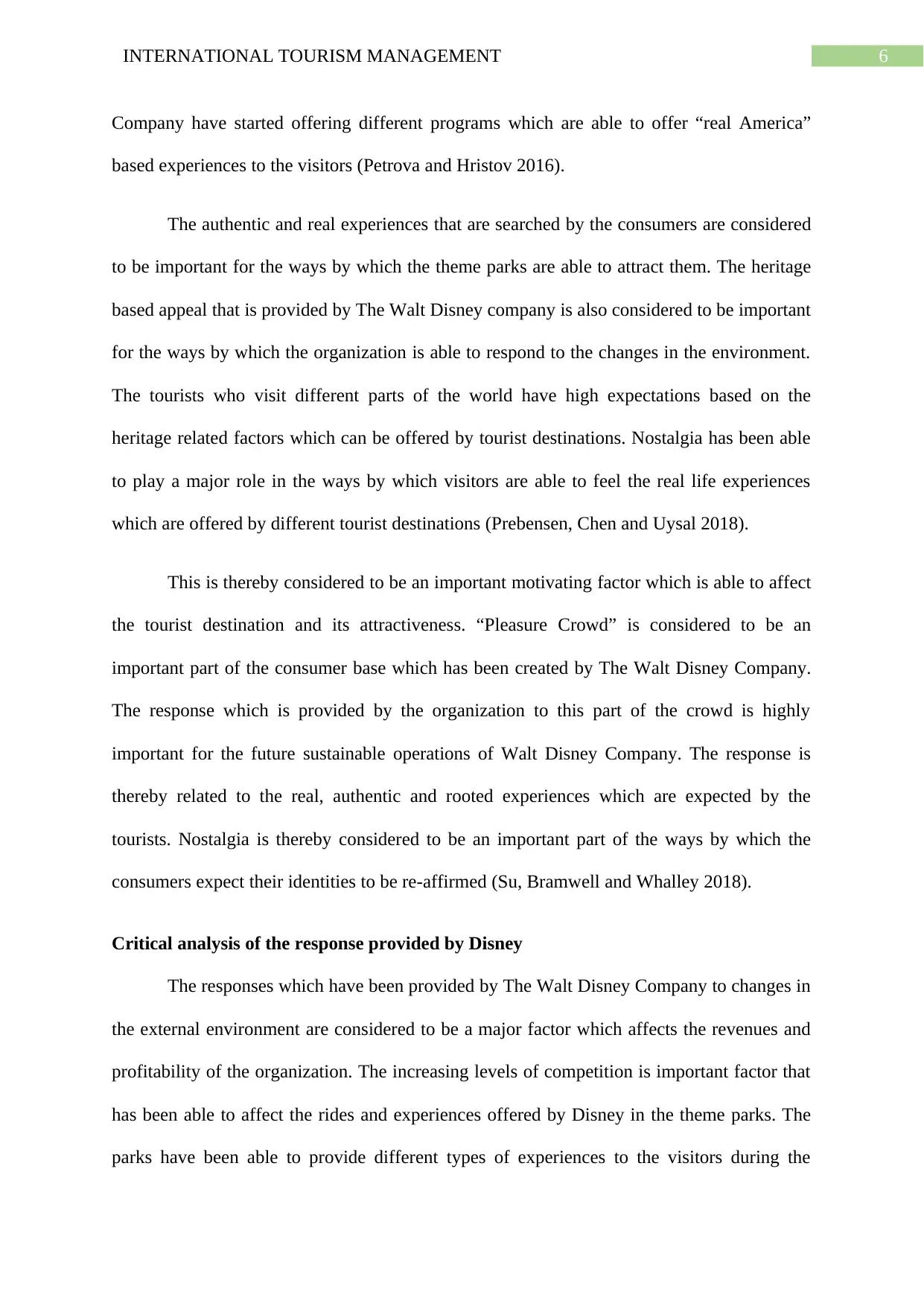
6INTERNATIONAL TOURISM MANAGEMENT
Company have started offering different programs which are able to offer “real America”
based experiences to the visitors (Petrova and Hristov 2016).
The authentic and real experiences that are searched by the consumers are considered
to be important for the ways by which the theme parks are able to attract them. The heritage
based appeal that is provided by The Walt Disney company is also considered to be important
for the ways by which the organization is able to respond to the changes in the environment.
The tourists who visit different parts of the world have high expectations based on the
heritage related factors which can be offered by tourist destinations. Nostalgia has been able
to play a major role in the ways by which visitors are able to feel the real life experiences
which are offered by different tourist destinations (Prebensen, Chen and Uysal 2018).
This is thereby considered to be an important motivating factor which is able to affect
the tourist destination and its attractiveness. “Pleasure Crowd” is considered to be an
important part of the consumer base which has been created by The Walt Disney Company.
The response which is provided by the organization to this part of the crowd is highly
important for the future sustainable operations of Walt Disney Company. The response is
thereby related to the real, authentic and rooted experiences which are expected by the
tourists. Nostalgia is thereby considered to be an important part of the ways by which the
consumers expect their identities to be re-affirmed (Su, Bramwell and Whalley 2018).
Critical analysis of the response provided by Disney
The responses which have been provided by The Walt Disney Company to changes in
the external environment are considered to be a major factor which affects the revenues and
profitability of the organization. The increasing levels of competition is important factor that
has been able to affect the rides and experiences offered by Disney in the theme parks. The
parks have been able to provide different types of experiences to the visitors during the
Company have started offering different programs which are able to offer “real America”
based experiences to the visitors (Petrova and Hristov 2016).
The authentic and real experiences that are searched by the consumers are considered
to be important for the ways by which the theme parks are able to attract them. The heritage
based appeal that is provided by The Walt Disney company is also considered to be important
for the ways by which the organization is able to respond to the changes in the environment.
The tourists who visit different parts of the world have high expectations based on the
heritage related factors which can be offered by tourist destinations. Nostalgia has been able
to play a major role in the ways by which visitors are able to feel the real life experiences
which are offered by different tourist destinations (Prebensen, Chen and Uysal 2018).
This is thereby considered to be an important motivating factor which is able to affect
the tourist destination and its attractiveness. “Pleasure Crowd” is considered to be an
important part of the consumer base which has been created by The Walt Disney Company.
The response which is provided by the organization to this part of the crowd is highly
important for the future sustainable operations of Walt Disney Company. The response is
thereby related to the real, authentic and rooted experiences which are expected by the
tourists. Nostalgia is thereby considered to be an important part of the ways by which the
consumers expect their identities to be re-affirmed (Su, Bramwell and Whalley 2018).
Critical analysis of the response provided by Disney
The responses which have been provided by The Walt Disney Company to changes in
the external environment are considered to be a major factor which affects the revenues and
profitability of the organization. The increasing levels of competition is important factor that
has been able to affect the rides and experiences offered by Disney in the theme parks. The
parks have been able to provide different types of experiences to the visitors during the
Paraphrase This Document
Need a fresh take? Get an instant paraphrase of this document with our AI Paraphraser
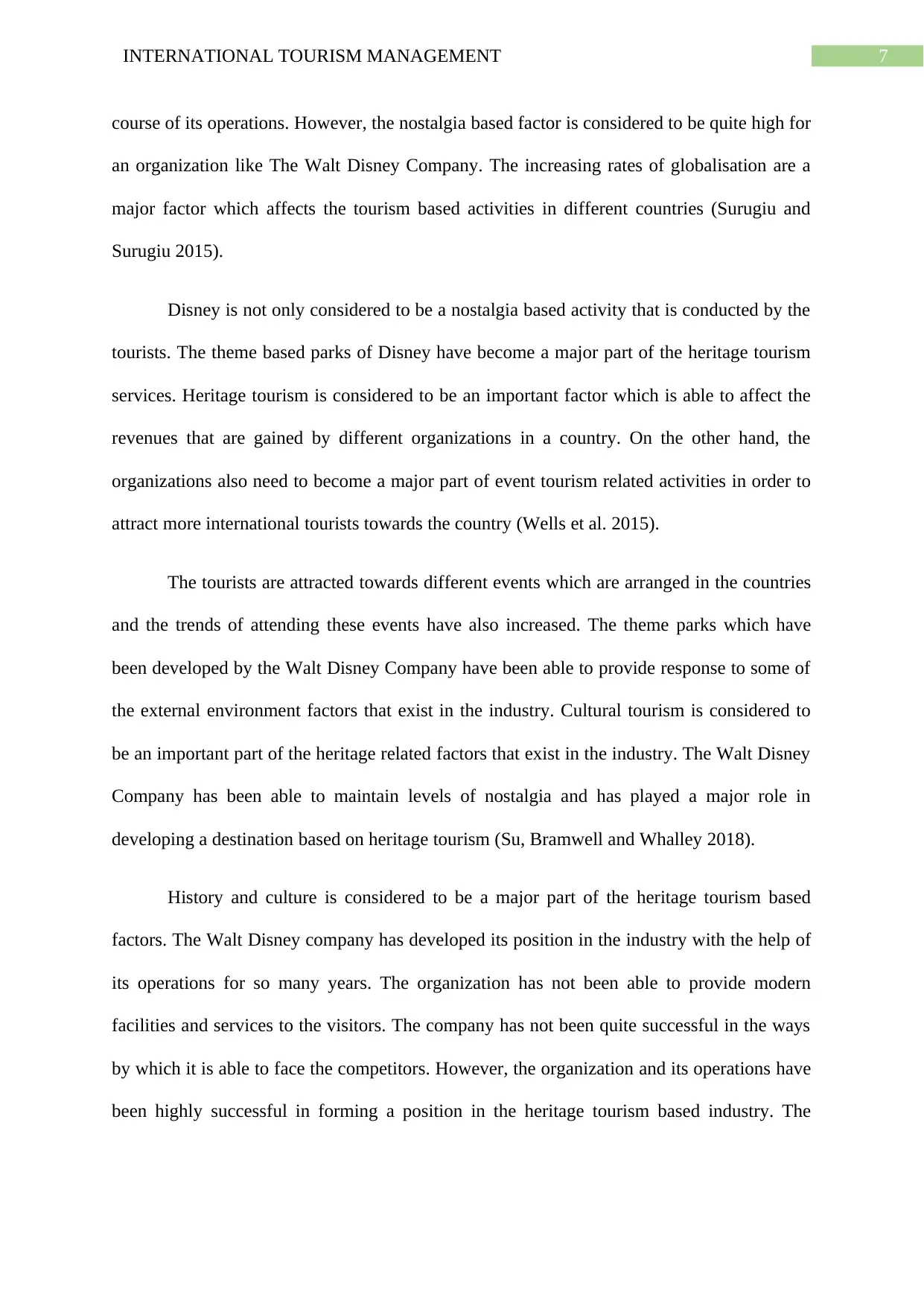
7INTERNATIONAL TOURISM MANAGEMENT
course of its operations. However, the nostalgia based factor is considered to be quite high for
an organization like The Walt Disney Company. The increasing rates of globalisation are a
major factor which affects the tourism based activities in different countries (Surugiu and
Surugiu 2015).
Disney is not only considered to be a nostalgia based activity that is conducted by the
tourists. The theme based parks of Disney have become a major part of the heritage tourism
services. Heritage tourism is considered to be an important factor which is able to affect the
revenues that are gained by different organizations in a country. On the other hand, the
organizations also need to become a major part of event tourism related activities in order to
attract more international tourists towards the country (Wells et al. 2015).
The tourists are attracted towards different events which are arranged in the countries
and the trends of attending these events have also increased. The theme parks which have
been developed by the Walt Disney Company have been able to provide response to some of
the external environment factors that exist in the industry. Cultural tourism is considered to
be an important part of the heritage related factors that exist in the industry. The Walt Disney
Company has been able to maintain levels of nostalgia and has played a major role in
developing a destination based on heritage tourism (Su, Bramwell and Whalley 2018).
History and culture is considered to be a major part of the heritage tourism based
factors. The Walt Disney company has developed its position in the industry with the help of
its operations for so many years. The organization has not been able to provide modern
facilities and services to the visitors. The company has not been quite successful in the ways
by which it is able to face the competitors. However, the organization and its operations have
been highly successful in forming a position in the heritage tourism based industry. The
course of its operations. However, the nostalgia based factor is considered to be quite high for
an organization like The Walt Disney Company. The increasing rates of globalisation are a
major factor which affects the tourism based activities in different countries (Surugiu and
Surugiu 2015).
Disney is not only considered to be a nostalgia based activity that is conducted by the
tourists. The theme based parks of Disney have become a major part of the heritage tourism
services. Heritage tourism is considered to be an important factor which is able to affect the
revenues that are gained by different organizations in a country. On the other hand, the
organizations also need to become a major part of event tourism related activities in order to
attract more international tourists towards the country (Wells et al. 2015).
The tourists are attracted towards different events which are arranged in the countries
and the trends of attending these events have also increased. The theme parks which have
been developed by the Walt Disney Company have been able to provide response to some of
the external environment factors that exist in the industry. Cultural tourism is considered to
be an important part of the heritage related factors that exist in the industry. The Walt Disney
Company has been able to maintain levels of nostalgia and has played a major role in
developing a destination based on heritage tourism (Su, Bramwell and Whalley 2018).
History and culture is considered to be a major part of the heritage tourism based
factors. The Walt Disney company has developed its position in the industry with the help of
its operations for so many years. The organization has not been able to provide modern
facilities and services to the visitors. The company has not been quite successful in the ways
by which it is able to face the competitors. However, the organization and its operations have
been highly successful in forming a position in the heritage tourism based industry. The
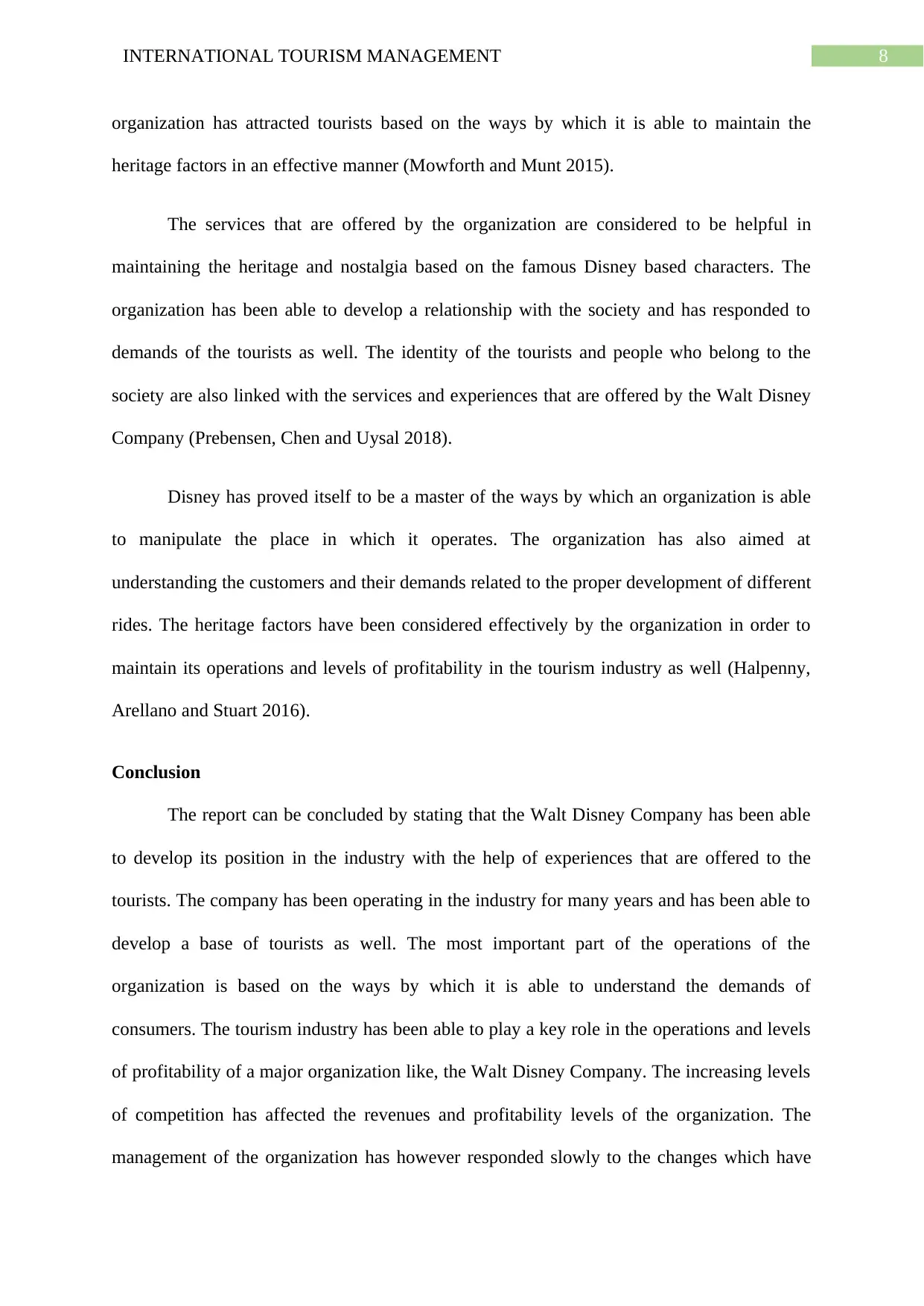
8INTERNATIONAL TOURISM MANAGEMENT
organization has attracted tourists based on the ways by which it is able to maintain the
heritage factors in an effective manner (Mowforth and Munt 2015).
The services that are offered by the organization are considered to be helpful in
maintaining the heritage and nostalgia based on the famous Disney based characters. The
organization has been able to develop a relationship with the society and has responded to
demands of the tourists as well. The identity of the tourists and people who belong to the
society are also linked with the services and experiences that are offered by the Walt Disney
Company (Prebensen, Chen and Uysal 2018).
Disney has proved itself to be a master of the ways by which an organization is able
to manipulate the place in which it operates. The organization has also aimed at
understanding the customers and their demands related to the proper development of different
rides. The heritage factors have been considered effectively by the organization in order to
maintain its operations and levels of profitability in the tourism industry as well (Halpenny,
Arellano and Stuart 2016).
Conclusion
The report can be concluded by stating that the Walt Disney Company has been able
to develop its position in the industry with the help of experiences that are offered to the
tourists. The company has been operating in the industry for many years and has been able to
develop a base of tourists as well. The most important part of the operations of the
organization is based on the ways by which it is able to understand the demands of
consumers. The tourism industry has been able to play a key role in the operations and levels
of profitability of a major organization like, the Walt Disney Company. The increasing levels
of competition has affected the revenues and profitability levels of the organization. The
management of the organization has however responded slowly to the changes which have
organization has attracted tourists based on the ways by which it is able to maintain the
heritage factors in an effective manner (Mowforth and Munt 2015).
The services that are offered by the organization are considered to be helpful in
maintaining the heritage and nostalgia based on the famous Disney based characters. The
organization has been able to develop a relationship with the society and has responded to
demands of the tourists as well. The identity of the tourists and people who belong to the
society are also linked with the services and experiences that are offered by the Walt Disney
Company (Prebensen, Chen and Uysal 2018).
Disney has proved itself to be a master of the ways by which an organization is able
to manipulate the place in which it operates. The organization has also aimed at
understanding the customers and their demands related to the proper development of different
rides. The heritage factors have been considered effectively by the organization in order to
maintain its operations and levels of profitability in the tourism industry as well (Halpenny,
Arellano and Stuart 2016).
Conclusion
The report can be concluded by stating that the Walt Disney Company has been able
to develop its position in the industry with the help of experiences that are offered to the
tourists. The company has been operating in the industry for many years and has been able to
develop a base of tourists as well. The most important part of the operations of the
organization is based on the ways by which it is able to understand the demands of
consumers. The tourism industry has been able to play a key role in the operations and levels
of profitability of a major organization like, the Walt Disney Company. The increasing levels
of competition has affected the revenues and profitability levels of the organization. The
management of the organization has however responded slowly to the changes which have
⊘ This is a preview!⊘
Do you want full access?
Subscribe today to unlock all pages.

Trusted by 1+ million students worldwide
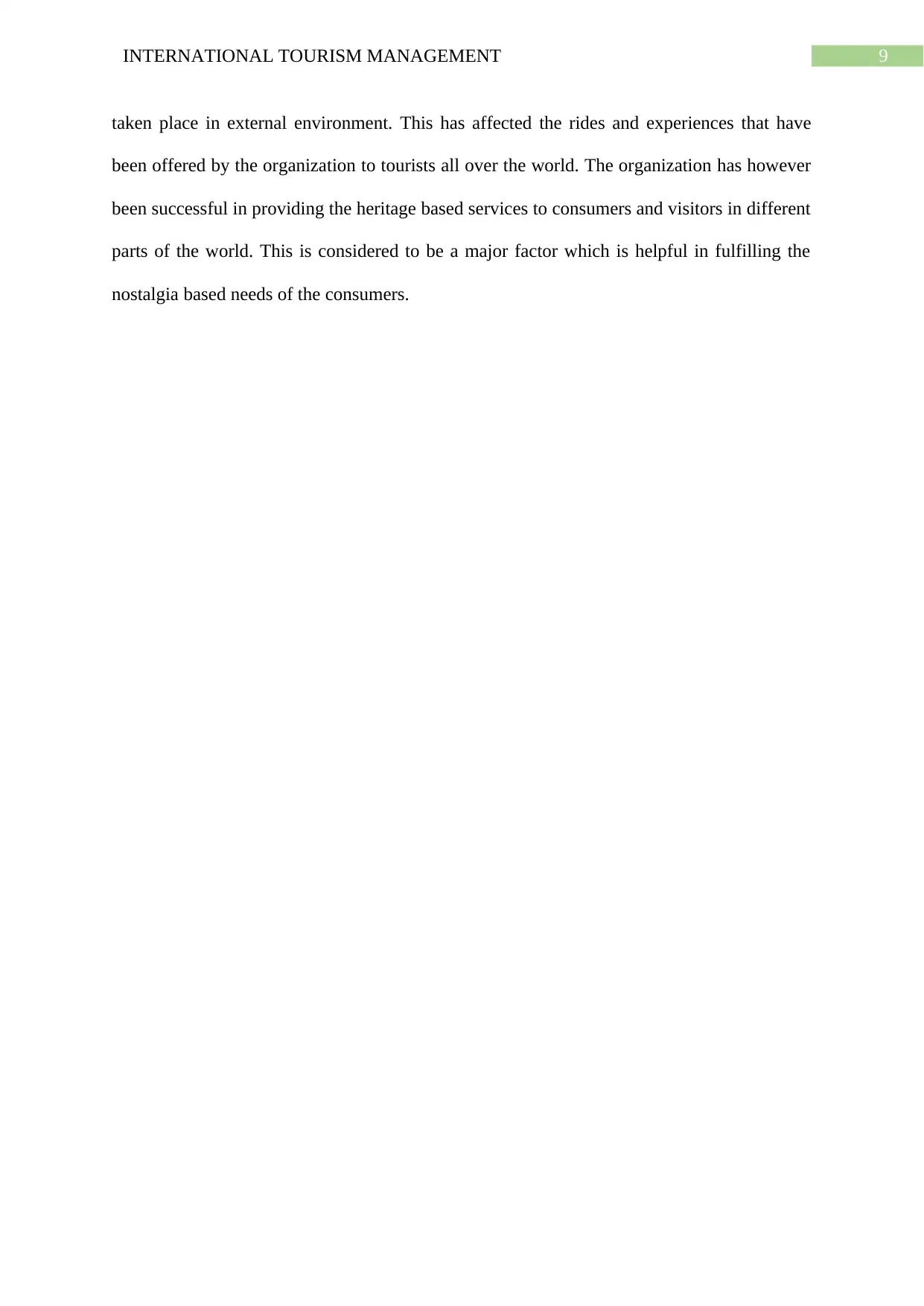
9INTERNATIONAL TOURISM MANAGEMENT
taken place in external environment. This has affected the rides and experiences that have
been offered by the organization to tourists all over the world. The organization has however
been successful in providing the heritage based services to consumers and visitors in different
parts of the world. This is considered to be a major factor which is helpful in fulfilling the
nostalgia based needs of the consumers.
taken place in external environment. This has affected the rides and experiences that have
been offered by the organization to tourists all over the world. The organization has however
been successful in providing the heritage based services to consumers and visitors in different
parts of the world. This is considered to be a major factor which is helpful in fulfilling the
nostalgia based needs of the consumers.
Paraphrase This Document
Need a fresh take? Get an instant paraphrase of this document with our AI Paraphraser
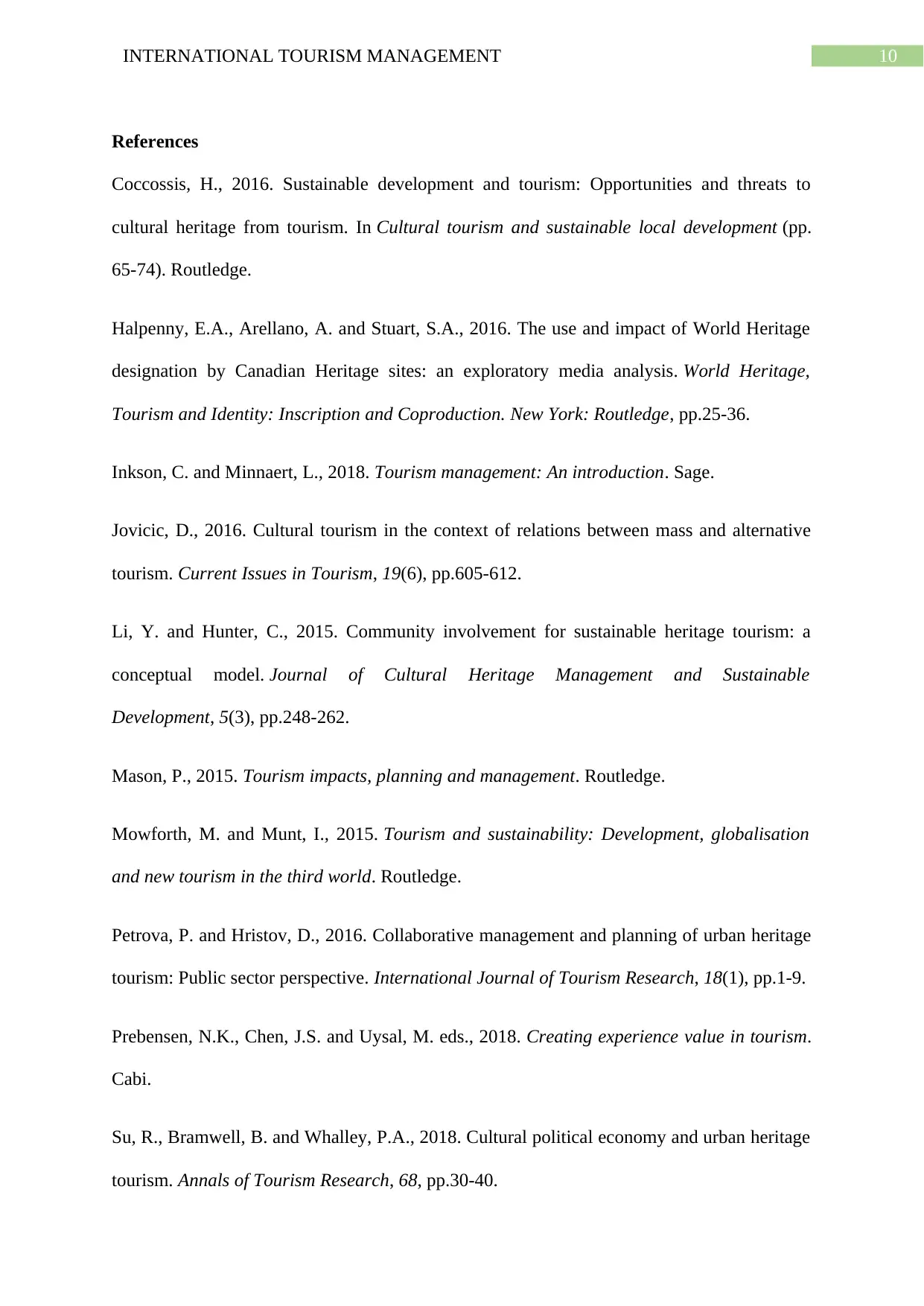
10INTERNATIONAL TOURISM MANAGEMENT
References
Coccossis, H., 2016. Sustainable development and tourism: Opportunities and threats to
cultural heritage from tourism. In Cultural tourism and sustainable local development (pp.
65-74). Routledge.
Halpenny, E.A., Arellano, A. and Stuart, S.A., 2016. The use and impact of World Heritage
designation by Canadian Heritage sites: an exploratory media analysis. World Heritage,
Tourism and Identity: Inscription and Coproduction. New York: Routledge, pp.25-36.
Inkson, C. and Minnaert, L., 2018. Tourism management: An introduction. Sage.
Jovicic, D., 2016. Cultural tourism in the context of relations between mass and alternative
tourism. Current Issues in Tourism, 19(6), pp.605-612.
Li, Y. and Hunter, C., 2015. Community involvement for sustainable heritage tourism: a
conceptual model. Journal of Cultural Heritage Management and Sustainable
Development, 5(3), pp.248-262.
Mason, P., 2015. Tourism impacts, planning and management. Routledge.
Mowforth, M. and Munt, I., 2015. Tourism and sustainability: Development, globalisation
and new tourism in the third world. Routledge.
Petrova, P. and Hristov, D., 2016. Collaborative management and planning of urban heritage
tourism: Public sector perspective. International Journal of Tourism Research, 18(1), pp.1-9.
Prebensen, N.K., Chen, J.S. and Uysal, M. eds., 2018. Creating experience value in tourism.
Cabi.
Su, R., Bramwell, B. and Whalley, P.A., 2018. Cultural political economy and urban heritage
tourism. Annals of Tourism Research, 68, pp.30-40.
References
Coccossis, H., 2016. Sustainable development and tourism: Opportunities and threats to
cultural heritage from tourism. In Cultural tourism and sustainable local development (pp.
65-74). Routledge.
Halpenny, E.A., Arellano, A. and Stuart, S.A., 2016. The use and impact of World Heritage
designation by Canadian Heritage sites: an exploratory media analysis. World Heritage,
Tourism and Identity: Inscription and Coproduction. New York: Routledge, pp.25-36.
Inkson, C. and Minnaert, L., 2018. Tourism management: An introduction. Sage.
Jovicic, D., 2016. Cultural tourism in the context of relations between mass and alternative
tourism. Current Issues in Tourism, 19(6), pp.605-612.
Li, Y. and Hunter, C., 2015. Community involvement for sustainable heritage tourism: a
conceptual model. Journal of Cultural Heritage Management and Sustainable
Development, 5(3), pp.248-262.
Mason, P., 2015. Tourism impacts, planning and management. Routledge.
Mowforth, M. and Munt, I., 2015. Tourism and sustainability: Development, globalisation
and new tourism in the third world. Routledge.
Petrova, P. and Hristov, D., 2016. Collaborative management and planning of urban heritage
tourism: Public sector perspective. International Journal of Tourism Research, 18(1), pp.1-9.
Prebensen, N.K., Chen, J.S. and Uysal, M. eds., 2018. Creating experience value in tourism.
Cabi.
Su, R., Bramwell, B. and Whalley, P.A., 2018. Cultural political economy and urban heritage
tourism. Annals of Tourism Research, 68, pp.30-40.
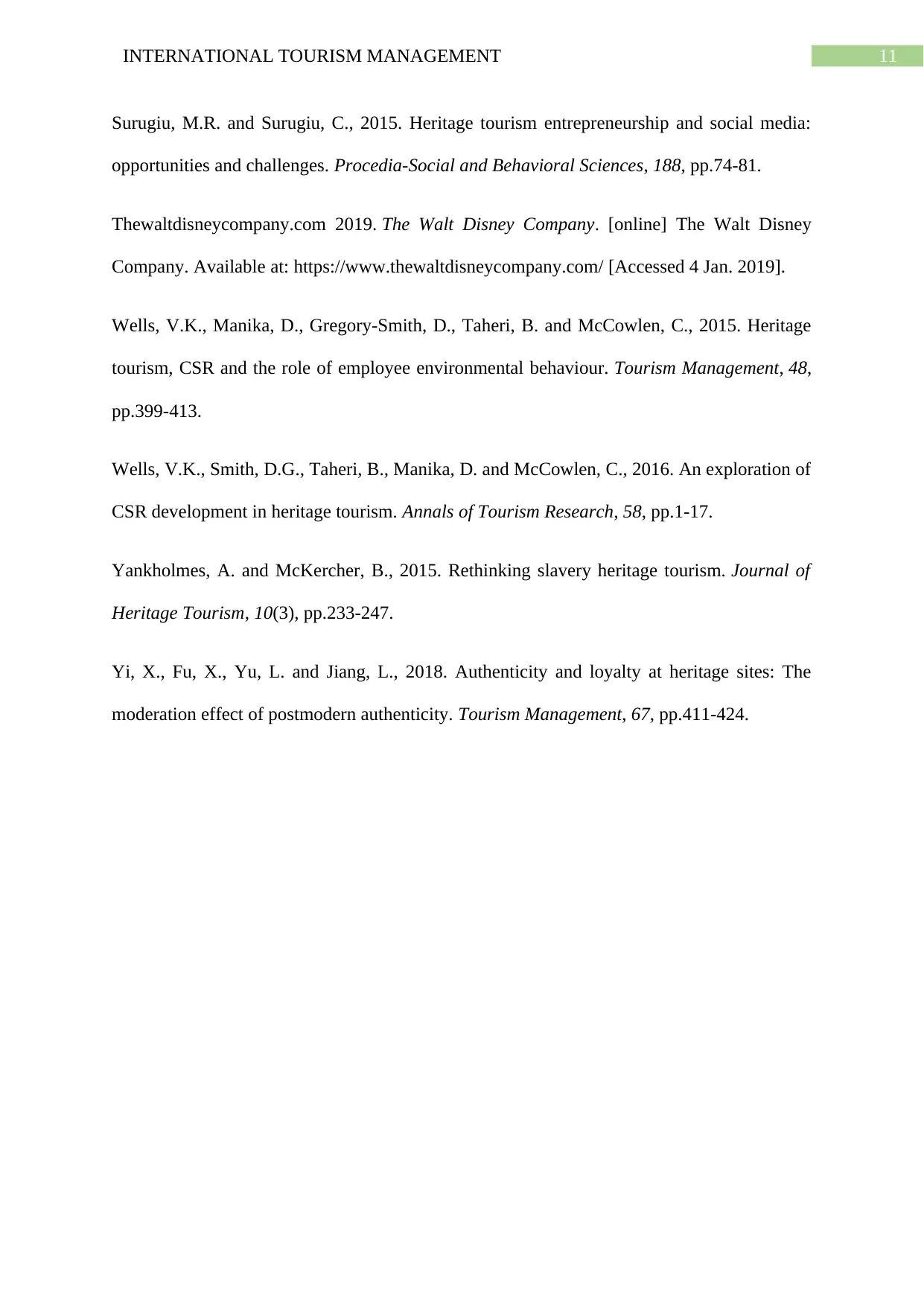
11INTERNATIONAL TOURISM MANAGEMENT
Surugiu, M.R. and Surugiu, C., 2015. Heritage tourism entrepreneurship and social media:
opportunities and challenges. Procedia-Social and Behavioral Sciences, 188, pp.74-81.
Thewaltdisneycompany.com 2019. The Walt Disney Company. [online] The Walt Disney
Company. Available at: https://www.thewaltdisneycompany.com/ [Accessed 4 Jan. 2019].
Wells, V.K., Manika, D., Gregory-Smith, D., Taheri, B. and McCowlen, C., 2015. Heritage
tourism, CSR and the role of employee environmental behaviour. Tourism Management, 48,
pp.399-413.
Wells, V.K., Smith, D.G., Taheri, B., Manika, D. and McCowlen, C., 2016. An exploration of
CSR development in heritage tourism. Annals of Tourism Research, 58, pp.1-17.
Yankholmes, A. and McKercher, B., 2015. Rethinking slavery heritage tourism. Journal of
Heritage Tourism, 10(3), pp.233-247.
Yi, X., Fu, X., Yu, L. and Jiang, L., 2018. Authenticity and loyalty at heritage sites: The
moderation effect of postmodern authenticity. Tourism Management, 67, pp.411-424.
Surugiu, M.R. and Surugiu, C., 2015. Heritage tourism entrepreneurship and social media:
opportunities and challenges. Procedia-Social and Behavioral Sciences, 188, pp.74-81.
Thewaltdisneycompany.com 2019. The Walt Disney Company. [online] The Walt Disney
Company. Available at: https://www.thewaltdisneycompany.com/ [Accessed 4 Jan. 2019].
Wells, V.K., Manika, D., Gregory-Smith, D., Taheri, B. and McCowlen, C., 2015. Heritage
tourism, CSR and the role of employee environmental behaviour. Tourism Management, 48,
pp.399-413.
Wells, V.K., Smith, D.G., Taheri, B., Manika, D. and McCowlen, C., 2016. An exploration of
CSR development in heritage tourism. Annals of Tourism Research, 58, pp.1-17.
Yankholmes, A. and McKercher, B., 2015. Rethinking slavery heritage tourism. Journal of
Heritage Tourism, 10(3), pp.233-247.
Yi, X., Fu, X., Yu, L. and Jiang, L., 2018. Authenticity and loyalty at heritage sites: The
moderation effect of postmodern authenticity. Tourism Management, 67, pp.411-424.
⊘ This is a preview!⊘
Do you want full access?
Subscribe today to unlock all pages.

Trusted by 1+ million students worldwide
1 out of 12
Related Documents
Your All-in-One AI-Powered Toolkit for Academic Success.
+13062052269
info@desklib.com
Available 24*7 on WhatsApp / Email
![[object Object]](/_next/static/media/star-bottom.7253800d.svg)
Unlock your academic potential
Copyright © 2020–2025 A2Z Services. All Rights Reserved. Developed and managed by ZUCOL.



